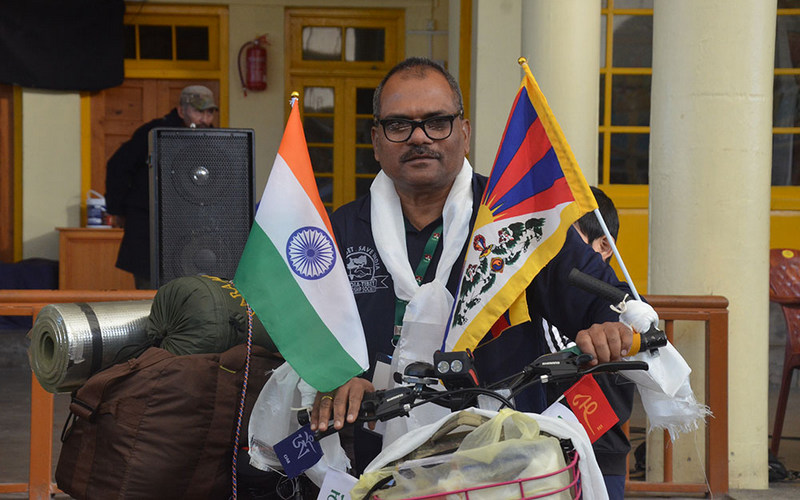Dharamshala, India — Sandesh Meshram, a regional convener of western region-I (Maharashtra & Goa) which is a core group for Tibetan cause-India. He will be campaigning for his bicycle rally entitled FOURTH JANJAGARAN CYCLE YATRA with the core message of FREE TIBET, SAVE INDIA.
Sandesh Meshram, the member of Indo-Tibet friendship society, will start his more than four-month-long bicycle rally from the Dalai Lama’s main temple on 1st December of 2019 till 10th March 2020. The occasion for the start of the campaign will be marked by the presence of Dr Kuldip Chand Agnihotri, the vice-chancellor of the Central University of Himachal Pradesh, Ajay Singh Mankotia, the president of Dharamshala, Indo-Tibet friendship Association and Choekyong Wangchuk, minister of health, Central Tibetan Administration. He will take off with traditional ceremonial scarves from the respective representatives and his well-wishers.
Sandesh’s fourth voluntary bicycle rally will cover over approximately around 7,500kms passing through 12 states of India beginning from Mcleod Ganj, Dharamshala of Himachal Pradesh, the official seat of Central Tibetan Administration and the residence of His Holiness the 14th Dalai Lama and will end at Mundgod, one of the largest Tibetan settlements in Karnataka.
The free-Tibet campaigner previously had organized three such cycle Yatras. The first voluntary bicycle rally took place in 2014 with the core message of Save Tibet Cycle Campaign started from Nagpur and covered over a distance of 4,000kms, crossing through five states including Madhya Pradesh, Chhattisgarh, Odisha, Andhra Pradesh, and Telangana.
Followed by his second cycle yatra in 2016 with a slogan of Bicycle Rally to Save Tibet which began at Nagpur, traveling through the states of Madhya Pradesh, Uttar Pradesh and ended in Bodh Gaya, Bihar covering over 1,200kms in total.
The third bicycle rally was in 2017 on 20th October to mark the Sino-Indian war, started from Bodh Gaya to Nathu-La Pass, Sikkim covering over 1,270kms.
The bicycle yatra aims to create awareness among the general Indian masses about Tibet and its hard realities prevailing under the brutal occupation of Tibet by the Communist Government of China.
This cycle campaign would also engage in re-strengthening the centuries-old relation between India and Tibet. The boundaries that India shares with Tibet, not China.
China and Tibet: Few facts everyone should know
- 1.2 Million Tibetans have been killed in this conflict since Tibet was violently and illegally occupied, according to international law, by China in 1949/1950. More than 100,000 Tibetans have been forced to flee their homeland and now live in Exile communities around the world. Until today, the rule of law or basic human rights is non-existent in Tibet. Surveillance, repression and arbitrary arrests are daily routines. Despite the continued suppression, the Tibetan people choose the path of non-violent resistance and for that, they deserve our utmost respect and full support.
- Over the past 70 decades, there has been ongoing political repression, social discrimination, economic marginalization, environmental destruction, and cultural assimilation, particularly due to Chinese migration to Tibet which is fueling intense resentment among the people of occupied Tibet.
- The communist-totalitarian state of China began its invasion of Tibet in 1949, reaching complete occupation of the country in 1959. Since that time, more than 1.2 million people, 20% of the nation's population of six million, have died as a direct result of China's invasion and occupation. In addition, over 99% of Tibet's six thousand religious monasteries, temples, and shrines, have been looted or decimated resulting in the destruction of hundreds of thousands of sacred Buddhist scriptures.
- Until 1949, Tibet was an independent nation in the Himalayas which had little contact with the rest of the world. It existed as a rich cultural storehouse — unifying theme among the Tibetans — as was their own language, literature, art, and world view developed by living at high altitudes, under harsh conditions, in a balance with their environment.


![Tibet has a rich history as a sovereign nation until the 1950s when it was invaded by China. [Photo: File]](/images/stories/Pics-2024/March/Tibet-Nation-1940s.jpg#joomlaImage://local-images/stories/Pics-2024/March/Tibet-Nation-1940s.jpg?width=1489&height=878)
















